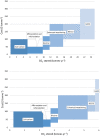Beyond the social cost of carbon: Negative emission technologies as a means for biophysically setting the price of carbon
- PMID: 31820259
- PMCID: PMC7320092
- DOI: 10.1007/s13280-019-01301-y
Beyond the social cost of carbon: Negative emission technologies as a means for biophysically setting the price of carbon
Abstract
The social cost of carbon (SCC) is an estimate of the costs that society will incur because of the emission of one tonne of CO2. Because of the large uncertainties in the effects of climate change and the subjectivity of the discount rate, estimates of SCC range widely, from - 10.2 to 105 213$ t-1 in 2010 USD. Despite this range, the SCC has been used or proposed as a basis for a wide variety of policymaking including cost-benefit analysis and carbon taxes. The SCC suffers from several practical and philosophical weaknesses: it is anthropocentric, it neglects the acidification of oceans, it assumes that quantifiable economic variables like GDP are the primary costs that humans will experience from climate change, and it is impossible to quantify objectively. Further, the ethical implications of a carbon pricing policy include both the value of the carbon price, and the use of revenues generated by the policy. Thus, revenue neutral carbon policies as in some SCC-based proposals, are unlikely to be just. Here, we propose that the cost of emerging negative-emission technologies would be an alternative means for setting a carbon price and avoid these philosophical and practical weaknesses.
Keywords: Climate justice; Externality; Negative emission technology; Polluter pays principle; Social cost of carbon.
Figures





Similar articles
-
Carbon pricing of food in Australia: an analysis of the health, environmental and public finance impacts.Aust N Z J Public Health. 2018 Dec;42(6):523-529. doi: 10.1111/1753-6405.12830. Epub 2018 Oct 8. Aust N Z J Public Health. 2018. PMID: 30296820
-
A fair and progressive carbon price for a sustainable economy.J Environ Manage. 2022 Feb 1;303:113935. doi: 10.1016/j.jenvman.2021.113935. Epub 2021 Nov 23. J Environ Manage. 2022. PMID: 34836677
-
The social cost of carbon driven by green behaviors.PLoS One. 2023 Jun 30;18(6):e0286534. doi: 10.1371/journal.pone.0286534. eCollection 2023. PLoS One. 2023. PMID: 37390053 Free PMC article.
-
Health co-benefits and trade-offs of carbon pricing: a narrative synthesis.Clim Policy. 2024 Jun 2;24(10):1346-1364. doi: 10.1080/14693062.2024.2356822. eCollection 2024. Clim Policy. 2024. PMID: 39483612 Free PMC article. Review.
-
Valuing Health Impacts In Climate Policy: Ethical Issues And Economic Challenges.Health Aff (Millwood). 2020 Dec;39(12):2105-2112. doi: 10.1377/hlthaff.2020.01117. Health Aff (Millwood). 2020. PMID: 33284691 Free PMC article. Review.
Cited by
-
Main Challenges of Incorporating Environmental Impacts in the Economic Evaluation of Health Technology Assessment: A Scoping Review.Int J Environ Res Public Health. 2023 Mar 11;20(6):4949. doi: 10.3390/ijerph20064949. Int J Environ Res Public Health. 2023. PMID: 36981859 Free PMC article.
References
-
- Ackerman F, Stanton EA. Climate risks and carbon prices: Revising the social cost of carbon. Economics. 2012;6:1–25.
-
- Anthoff D, Tol RS. The uncertainty about the social cost of carbon: A decomposition analysis using fund. Climatic Change. 2013;117:515–530.
-
- Archer D, Eby M, Brovkin V, Ridgwell A, Cao L, Mikolajewicz U, Caldeira K, Matsumoto K, et al. Atmospheric lifetime of fossil fuel carbon dioxide. Annual Review of Earth and Planetary Sciences. 2009;37:117–134.
-
- Batavia C, Nelson MP. For goodness sake! What is intrinsic value and why should we care? Biological Conservation. 2017;209:366–376.
-
- Beck M, Krueger T. The epistemic, ethical, and political dimensions of uncertainty in integrated assessment modeling. Wiley Interdisciplinary Reviews: Climate Change. 2016;7:627–645.
MeSH terms
Substances
LinkOut - more resources
Full Text Sources
Medical
Research Materials

